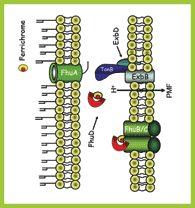
Over-prescribing anti-bacterial drugs allows their targets the opportunity to adapt. Kill off a billion bacteria using penicillin and a few billion more will come along—and brush aside previously successful weapons.
Antibiotic-resistant microbes are becoming more dangerous every year, creating deadlier forms of previously treatable diseases such as meningitis and pneumonia. But there is hope. McGill researchers have made a fundamental advance that may combat the growing problem of antibiotic resistance. The team, led by James Coulton, a professor in the Department of Microbiology and Immunology, has mapped the first known three-dimensional structure of a protein complex involved in bacterial iron uptake. Understanding how bacteria access nutrients essential to their survival, such as iron, could allow for the development of a new class of drugs that kill infectious bacteria—by starving them. The researchers’ findings were published in the June 2006 issue of Science.
This research was funded by the Canadian Institutes of Health Research, the Canada Foundation for Innovation and the Natural Sciences and Engineering Research Council of Canada.
